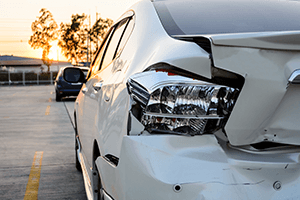3. Getting to grips with insurance & road tax
One of the most expensive aspects of owning a vehicle is paying for the insurance. As a young or new driver particularly, this is where you're likely to be spending a vast amount of money and as such, it pays to know how you can reduce the costs and get a better deal. In this section we'll not only run you through the joys of insurance, but also help you understand road tax too.
Why is insurance expensive for young drivers?
This is a problem that has been afflicting young drivers for many years now. Unfortunately, all young motorists are grouped together and labelled as high risk drivers. As such, 17-24 year-olds pay the most expensive annual premiums.
Young males have it worst and staggeringly, a male driver of 17 or 18 will pay on average £2,200 for their annual insurance. Young women of the same age don't get off lightly either and pay close to £2,000 each year.
With insurers no longer legally entitled to take gender into account when calculating insurance premiums, unfortunately for younger motorists the cost is simply going to keep on rising.
One of the major causes of expensive car insurance for the younger generation is because of the high level of risk. Based on national statistics, those under the age of 25 are far more likely to be involved in a road collision. In fact, the AA reports that a quarter of all road incidents involve drivers in this demographic.
On top of this risk factor, there's also the underlying fact that these motorists haven't had the time and experience to build up their no claims bonus. For insurers, this is crucial when it comes to reducing premiums and unfortunately for younger motorists, they're stung because of the inexperience.
With car insurance it's always worth comparing different companies and finding the best ways to help reduce your premiums. This in particular will be discussed later in the section.
The various policies available for car insurance
With car insurance it's not just a case of one size fits all. The insurer will assess your risk factor and the value of the vehicle, before deciding on how much premium you'll need to pay. Your risk factor will be determined by your age and driving history. Any accidents or claims over the years will be taken into consideration.
However, when it comes to deciding on a policy, there are three to choose from.
These are third party, third party fire and theft, and fully comprehensive.

Third party car insurance:
Third party insurance is the minimum level of cover you can apply for in Britain. As such, it's a basic cover offering limited protection. In the event of an accident your insurers will pay out for the repairs of the other vehicle involved. However, your vehicle will not be covered for damage, fire or even theft.
For this very reason, third party insurance is often popular for motorists with an older, inexpensive vehicle. It's typically the cheaper insurance option too, so if you're looking to save a little money you could opt for this.
The only problem here though is because of the relatively cheap cost, young motorists have taken this option and therefore pushed up the overall price. Therefore, whilst you would expect it to be your cheapest option, it's worth looking at the other insurance policies to see if there's a better deal available.

Third party, fire and theft insurance:
One up from standard third party when it comes to your insurance protection, is third party fire and theft. This form of insurance not only covers you in the same way as third party, but as it says in the name will also protect against fire and theft of your own vehicle.
Again, this option is perfect for those with a cheaper vehicle who aren't too worried about the prospect of not receiving money for repairs. Also, typically third party, fire and theft should be cheaper than fully comprehensive cover.
As with standard third party though, it's worth having a look around the market and comparing deals to ensure you get a great price.

Fully comprehensive car insurance:
Fully comprehensive cover offers the greatest level of protection for those insuring their vehicle. You'll receive all the perks of third party fire and theft, but your vehicle will also be covered should you be involved in a road accident.
With comprehensive cover though, it's worthwhile reading the small print as there can often be some difference in the technicalities of the contract. For instance, some forms of cover won't entitle you to drive another vehicle, whilst some don't cover overseas travelling either.
There's also the possibility of adding extras to your agreement too, such as breakdown cover, legal expenses and even courtesy cars should your vehicle be out of action. Therefore, it's worthwhile comparing various companies to discover the best deal available.
Tips for reducing your car insurance premiums
Car insurance can be expensive, there's no denying this. However, you don't always have to pay the full price. Instead, there are some great ways to help you reduce the overall cost and save a fortune in the process.
Take a look at the following tips for slashing your insurance premiums:
-
1. Insure a cheap vehicle
Whenever shopping for a car, as a new driver it's important to factor insurance into the equation. Vehicles are grouped into specific insurance groups and as such, this will play a significant role in your decision. Therefore, find a vehicle that's cheap to drive and save yourself some money. -
2. Avoid modifications
Young drivers are always attracted to modifications, but these are likely to top up your premiums. Whether it's alloy wheels or body kits, avoid the temptation and keep your insurance costs down. -
3. Take the Pass Plus
After passing your driving test, the last thing you'll probably want to do is be taking more lessons. Yet this is exactly how you can lower insurance costs. The Pass Plus scheme is intended to improve your basic driving skills and is valued highly by insurers. It's only a six-hour stint and will take you onto motorways and give you an experience of night driving. Not only will the Pass Plus scheme improve your driving skills, but it's possible to save up to 35% on your first year's. -
4.Get a black box
Many insurers now offer black boxes to young motorists as a way of helping them reduce the outlay. These gadgets are fitted into the vehicle and monitor driving. Breaking speed limits and driving in an unsafe manner could result in penalisations from the insurer, whilst driving diligently would be favourable in receiving a reduction in premiums. With a black box there's the potential to save hundreds of pounds each year. -
5. Increase your excess
Excess is the amount you'll have to pay before your insurers cover the vehicle's damage. You can start from an excess of £0 if you wish, but as you'd expect the insurance premiums will be more expensive. If you want to bring down your monthly payments though, consider increasing the excess you'd pay. Just make sure not to set this too high! -
6. Make no assumptions
Just because third party cover should be the cheapest option, it doesn't mean this will always be the case. In fact, it's surprisingly common for fully comprehensive protection to be the cheapest bet so make sure to compare contracts and save money on your next premium. -
7. Add a named driver
As a young motorist you won't have built up enough driving experience to warrant cheap insurance. However, if you live with a partner or your parents who may use the vehicle, it's worth adding them to the insurance to bring down your costs. -
8. Pay annually
When arranging your insurance you'll have two options; to pay monthly or annually. Whilst monthly payments look enticing with smaller chunks, they'll add up to a greater amount than when choosing an annual cost.
How to pay for and reduce your road tax
Aside from car insurance, another of your annual expenses will be road tax. There has been a significant change in how this is paid in recent years and for the first time in 93 years you no longer need to place a tax disc in view. However, you must still pay the tax regardless.
Rather than a visible check to see if your car is insured, road cameras will instead use number plate recognition. If you're caught without road tax for your vehicle, you face a hefty fine.
There are also now changes in what happens when selling your car with tax left remaining, so it's worth getting an overview of what has been altered.
In October 2014, the tax discs were removed and a new system implemented for paying. The government decided on the system's review in an effort to save money.
It's also tougher now to avoid paying your road tax. It's not just a visual check, but road cameras can also scan your number plate. You can pay for your road tax in a number of ways too; whether it's monthly, quarterly or even annually. It's also possible to set-up a direct debit.
Any vehicle you purchase will need to be taxed. The previous owner (if there was one) would have reclaimed their tax payment from the government, so the car is currently uninsured. The DVLA will send reminder letters when your road tax is due to the address your vehicle is registered at, so there's no excuse for failing to pay.
The amount you pay in car tax will vary too, depending on the vehicle you own and the level of emissions it releases into the environment. This is exactly why zero emission cars (eco-friendly) have become incredibly popular. Electric and low emission vehicles have to pay little or no road tax.
Road tax bands
When viewing a new car, it's worth checking out its road tax band, to discover how much you'll need to pay each year. See the table below for more information:
| Tax Band | CO2 Emissions (g/km) | Annual Tax Payment |
|---|---|---|
| A | Up to 100 | £0.00 |
| B | 101 - 110 | £20.00 |
| C | 111 - 120 | £30.00 |
| D | 121 - 130 | £110.00 |
| E | 131 - 140 | £130.00 |
| F | 141 - 150 | £145.00 |
| G | 151 - 160 | £180.00 |
| H | 161 - 170 | £205.00 |
| I | 171 - 180 | £225.00 |
| J | 181 - 190 | £265.00 |
| K | 191 - 200 | £290.00 |
| L | 201 - 225 | £490.00 |
| M | 226 - 255 | £505.00 |